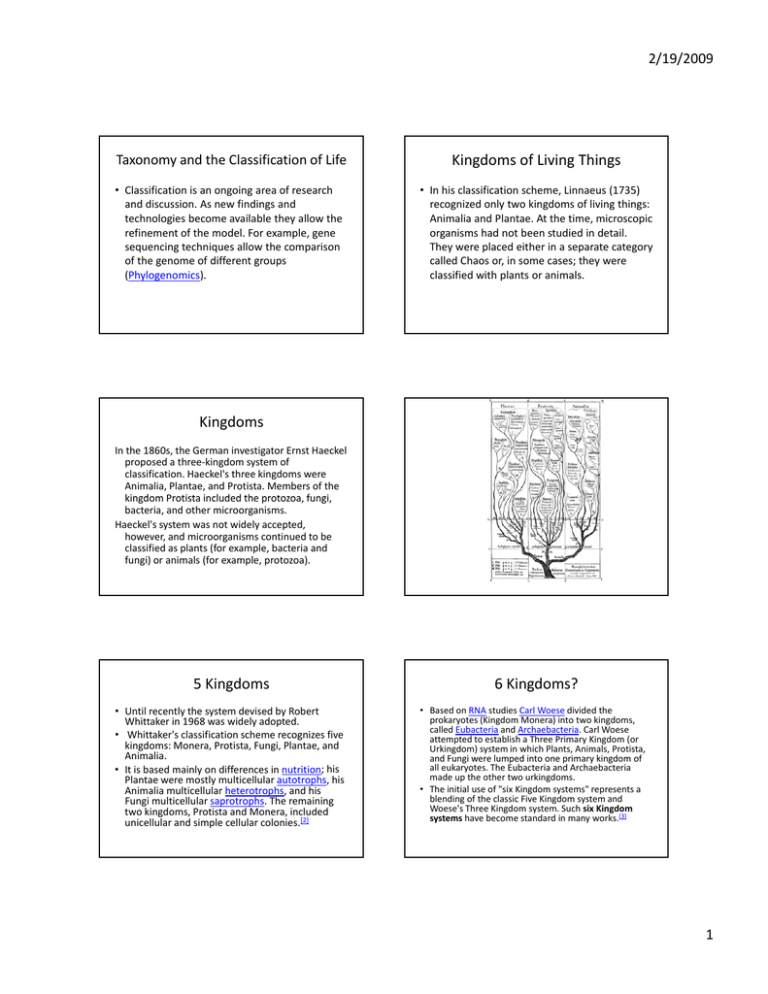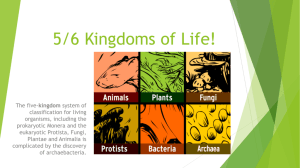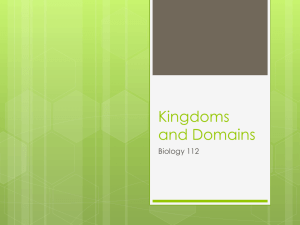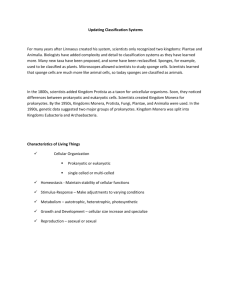Kingdoms of Living Things 2/19/2009 Taxonomy and the Classification of Life
advertisement

2/19/2009 Taxonomy and the Classification of Life Kingdoms of Living Things • Classification is an ongoing area of research and discussion. As new findings and technologies become available they allow the refinement of the model For example gene refinement of the model. For example, gene sequencing techniques allow the comparison of the genome of different groups (Phylogenomics). • In his classification scheme, Linnaeus (1735) recognized only two kingdoms of living things: Animalia and Plantae. At the time, microscopic organisms had not been studied in detail organisms had not been studied in detail. They were placed either in a separate category called Chaos or, in some cases; they were classified with plants or animals. Kingdoms In the 1860s, the German investigator Ernst Haeckel proposed a three‐kingdom system of classification. Haeckel's three kingdoms were Animalia, Plantae, and Protista. Members of the kingdom Protista included the protozoa, fungi, kingdom Protista included the protozoa fungi bacteria, and other microorganisms. Haeckel's system was not widely accepted, however, and microorganisms continued to be classified as plants (for example, bacteria and fungi) or animals (for example, protozoa). 5 Kingdoms 6 Kingdoms? • Until recently the system devised by Robert Whittaker in 1968 was widely adopted. • Whittaker's classification scheme recognizes five kingdoms: Monera, Protista, Fungi, Plantae, and Animalia. Animalia • It is based mainly on differences in nutrition; his Plantae were mostly multicellular autotrophs, his Animalia multicellular heterotrophs, and his Fungi multicellular saprotrophs. The remaining two kingdoms, Protista and Monera, included unicellular and simple cellular colonies.[2] • Based on RNA studies Carl Woese divided the prokaryotes (Kingdom Monera) into two kingdoms, called Eubacteria and Archaebacteria. Carl Woese attempted to establish a Three Primary Kingdom (or Urkingdom) system in which Plants, Animals, Protista, and Fungi were lumped into one primary kingdom of and Fungi were lumped into one primary kingdom of all eukaryotes. The Eubacteria and Archaebacteria made up the other two urkingdoms. • The initial use of "six Kingdom systems" represents a blending of the classic Five Kingdom system and Woese's Three Kingdom system. Such six Kingdom systems have become standard in many works.[3] 1 2/19/2009 6 Kingdom • 2 Empires: • 6 Kingdoms • Prokaryota: Linnaeus[5] (1735) 2 kingdoms Haeckel[6] (1866) 3 kingdoms Animalia Animalia – Bacteria • Eukaryota: – – – – – Animalia Plantae Fungi Chromista Protozoa Vegetabilia Plantae Chatton[7] (1925) 2 groups Copeland[8] (1938) 4 kingdoms Whittaker[2] Woese [9][10] (1969) (1977,1990) 5 kingdoms 3 domains Animalia Animalia Plantae Plantae Eukaryote Eukarya Fungi Protoctista Protista (not treated) Protista Archaea Procaryote Monera Monera Bacteria What are the 7 kingdoms of biology? • Wikipedia: There should be only 5 kingdoms: Animalia, Plantae, Fungi, Protista and Prokaryota. Unless you're talking about the different phyla/divisions within. • Some USA biology faculty recognize 7 kingdoms Geologic Time Scale • 12 hour clock: – 2:40 AM life began – 8:48 PM Cambrian explosion – 9:20 PM vertebrates arise – 11:02 PM mammals arise – 11:59:02 PM man arise – Last 10 seconds – fire – Last 100 msec – writing – Last nanosec – cell phones! Geologic Time Scale • • • • • • • Earth: 4.5 billion years old. Life: 4 billion years. Vertebrates: 500 million Mammals: 180 million Man: 3 million Fire: 500,000 years ? Writing: 5,000 years Geologic Time Scale • Most of the history of life was dominated by blue‐green algae (90% of 4 billion years) • Then sexual reproduction arose as an out come of the Cambrian Epoch (last 10%) come of the Cambrian Epoch (last 10%) – This introduced biological uncertainty – Rapid rates of formation of new species 2




